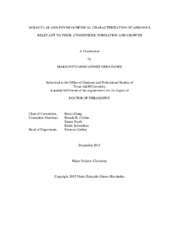| dc.description.abstract | This dissertation is aimed at understanding the molecular composition and physical chemistry of secondary organic aerosols (SOA) and, in particular, the processes that lead to their formation and growth. Several analytical and experimental methods have been developed and employed to characterize the chemical composition of nano- to sub-micrometer-sized particles and to obtain kinetic data and physiochemical properties of SOA. The first part of this dissertation describes the development, calibration, and application of Thermal Desorption Chemical Ionization Ion Drift Mass Spectrometry (TD-ID-CIMS) designed for the collection and chemical analysis of nucleation to accumulation mode aerosols with sizes between 2 and 200 nm. The TD-ID-CIMS instrument has been applied to the analysis of collected nano- to sub-micrometer-sized aerosol samples or injected bulk solutions.
The uptake coefficient (γ) and the Henry’s law constant (H*) for the heterogeneous reaction of gas-phase glyoxal on liquid sulfuric acid surfaces have been obtained using a laminar flow reactor coupled to ion drift – chemical ionization mass spectrometry (ID-CIMS) detection. The results show that both the uptake coefficient and Henry’s law constant increase with decreasing acid concentration and temperature, indicating a reaction mechanism of hydration followed by oligomerization for glyoxal on acidic media and suggesting an efficient aqueous reaction of glyoxal on hygroscopic particles leading to SOA formation.
The hygroscopicity, deliquescence, and cloud condensation nuclei activity of several alkylaminium carboxylate aerosols with sizes between 46 and 151 nm have been measured using a Hygroscopicity Tandem Differential Mobility Analyser (H-TDMA), a Condensation Particle Counter (CPC) and a Cloud Condensation Nuclei counter (CCN). Our results indicate that, dependent of their molecular functionality, alkylaminium carboxylate aerosols exhibit distinct hygroscopic, CCN, and deliquescent characteristics.
Finally, the heterogeneous conversion of sulfur dioxide to sulfate in the presence of gaseous nitrogen dioxide and ammonia has been investigated to evaluate sulfate formation under polluted environments. Experiments were performed utilizing a 1 m^3 chamber connected to a TDMA-CPC assembly and the TD-ID-CIMS instrument. Our results show that the extent of sulfate formation and particle growth is dependent on the gas concentrations of SO2, NO2, and NH3, but not sensitive to light. The results may lead to a better understanding of the formation of haze in polluted environments. | en |


